check engine light Lancia Musa 2012 Owner handbook (in English)
[x] Cancel search | Manufacturer: LANCIA, Model Year: 2012, Model line: Musa, Model: Lancia Musa 2012Pages: 218, PDF Size: 3.91 MB
Page 128 of 218
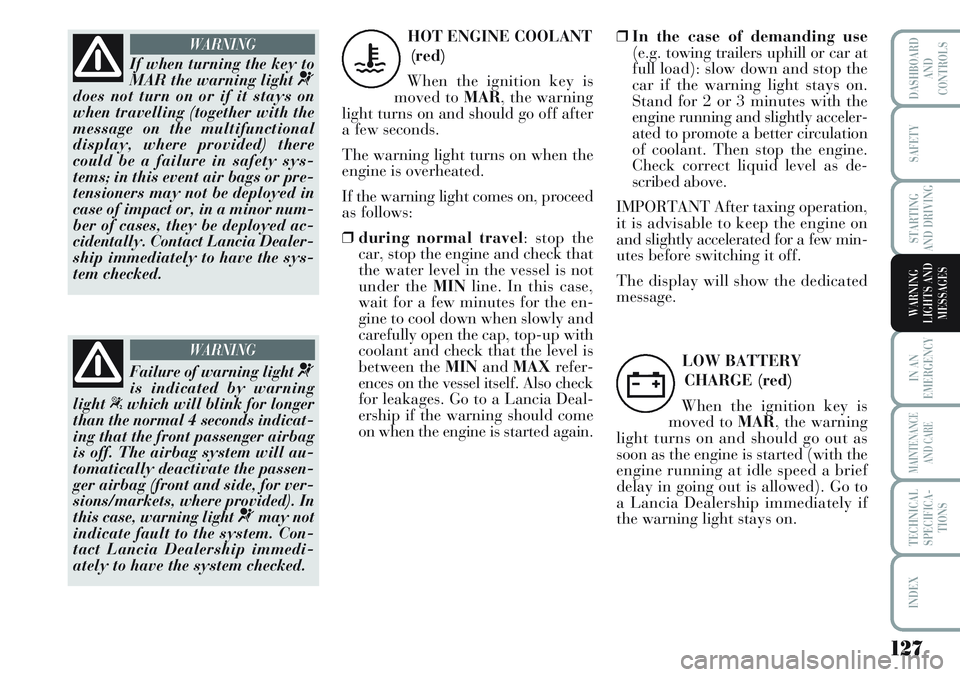
127
IN AN
EMERGENCY
MAINTENANCE
AND CARE
TECHNICAL
SPECIFICA-
TIONS
INDEX
DASHBOARD
AND
CONTROLS
SAFETY
STARTING
AND DRIVING
WARNING
LIGHTS AND
MESSAGES
If when turning the key to
MAR the warning light ¬does not turn on or if it stays on
when travelling (together with the
message on the multifunctional
display, where provided) there
could be a failure in safety sys-
tems; in this event air bags or pre-
tensioners may not be deployed in
case of impact or, in a minor num-
ber of cases, they be deployed ac-
cidentally. Contact Lancia Dealer-
ship immediately to have the sys-
tem checked.
Failure of warning light
¬is indicated by warning
light“which will blink for longer
than the normal 4 seconds indicat-
ing that the front passenger airbag
is off. The airbag system will au-
tomatically deactivate the passen-
ger airbag (front and side, for ver-
sions/markets, where provided). In
this case, warning light
¬may not
indicate fault to the system. Con-
tact Lancia Dealership immedi-
ately to have the system checked.
WARNING
WARNING
HOT ENGINE COOLANT
(red)
When the ignition key is
moved to MAR, the warning
light turns on and should go off after
a few seconds.
The warning light turns on when the
engine is overheated.
If the warning light comes on, proceed
as follows:
❒during normal travel: stop the
car, stop the engine and check that
the water level in the vessel is not
under the MINline. In this case,
wait for a few minutes for the en-
gine to cool down when slowly and
carefully open the cap, top-up with
coolant and check that the level is
between the MINandMAXrefer-
ences on the vessel itself. Also check
for leakages. Go to a Lancia Deal-
ership if the warning should come
on when the engine is started again.
u
❒In the case of demanding use
(e.g. towing trailers uphill or car at
full load): slow down and stop the
car if the warning light stays on.
Stand for 2 or 3 minutes with the
engine running and slightly acceler-
ated to promote a better circulation
of coolant. Then stop the engine.
Check correct liquid level as de-
scribed above.
IMPORTANT After taxing operation,
it is advisable to keep the engine on
and slightly accelerated for a few min-
utes before switching it off.
The display will show the dedicated
message.
LOW BATTERY
CHARGE (red)
When the ignition key is
moved to MAR, the warning
light turns on and should go out as
soon as the engine is started (with the
engine running at idle speed a brief
delay in going out is allowed). Go to
a Lancia Dealership immediately if
the warning light stays on.
w
Page 131 of 218
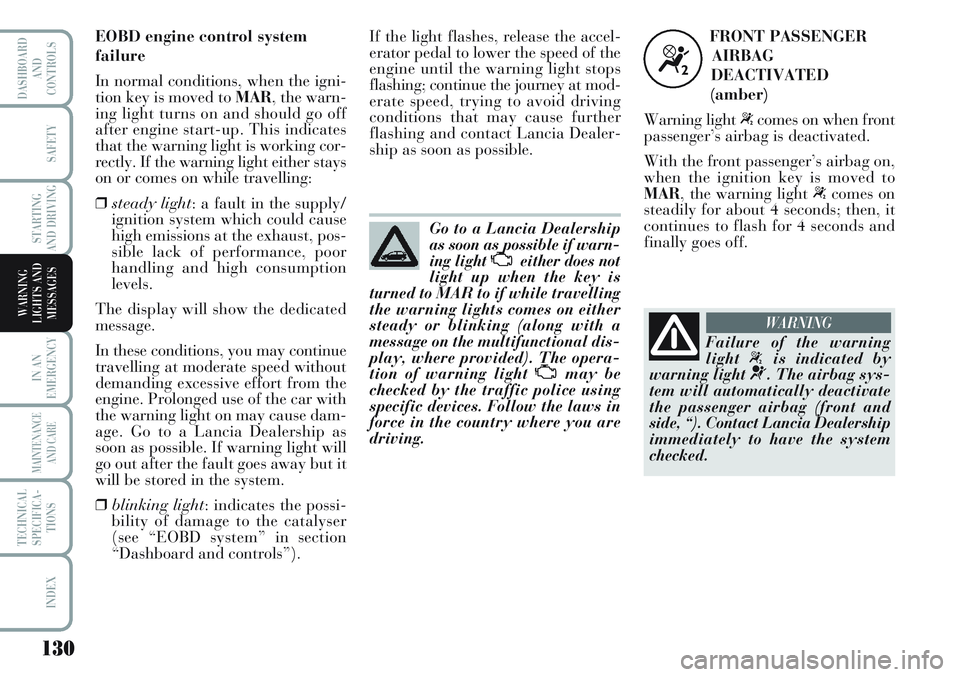
130
IN AN
EMERGENCY
MAINTENANCE
AND CARE
TECHNICAL
SPECIFICA-
TIONS
INDEX
DASHBOARD
AND
CONTROLS
SAFETY
STARTING
AND DRIVING
WARNING
LIGHTS AND
MESSAGES
Go to a Lancia Dealership
as soon as possible if warn-
ing light
Ueither does not
light up when the key is
turned to MAR to if while travelling
the warning lights comes on either
steady or blinking (along with a
message on the multifunctional dis-
play, where provided). The opera-
tion of warning light
Umay be
checked by the traffic police using
specific devices. Follow the laws in
force in the country where you are
driving.
FRONT PASSENGER
AIRBAG
DEACTIVATED
(amber)
Warning light “comes on when front
passenger’s airbag is deactivated.
With the front passenger’s airbag on,
when the ignition key is moved to
MAR, the warning light “comes on
steadily for about 4 seconds; then, it
continues to flash for 4 seconds and
finally goes off.
“
Failure of the warning
light“is indicated by
warning light
¬. The airbag sys-
tem will automatically deactivate
the passenger airbag (front and
side, “). Contact Lancia Dealership
immediately to have the system
checked.
WARNING
EOBD engine control system
failure
In normal conditions, when the igni-
tion key is moved to MAR, the warn-
ing light turns on and should go off
after engine start-up. This indicates
that the warning light is working cor-
rectly. If the warning light either stays
on or comes on while travelling:
❒steady light: a fault in the supply/
ignition system which could cause
high emissions at the exhaust, pos-
sible lack of performance, poor
handling and high consumption
levels.
The display will show the dedicated
message.
In these conditions, you may continue
travelling at moderate speed without
demanding excessive effort from the
engine. Prolonged use of the car with
the warning light on may cause dam-
age. Go to a Lancia Dealership as
soon as possible. If warning light will
go out after the fault goes away but it
will be stored in the system.
❒blinking light: indicates the possi-
bility of damage to the catalyser
(see “EOBD system” in section
“Dashboard and controls”). If the light flashes, release the accel-
erator pedal to lower the speed of the
engine until the warning light stops
flashing; continue the journey at mod-
erate speed, trying to avoid driving
conditions that may cause further
flashing and contact Lancia Dealer-
ship as soon as possible.
Page 132 of 218
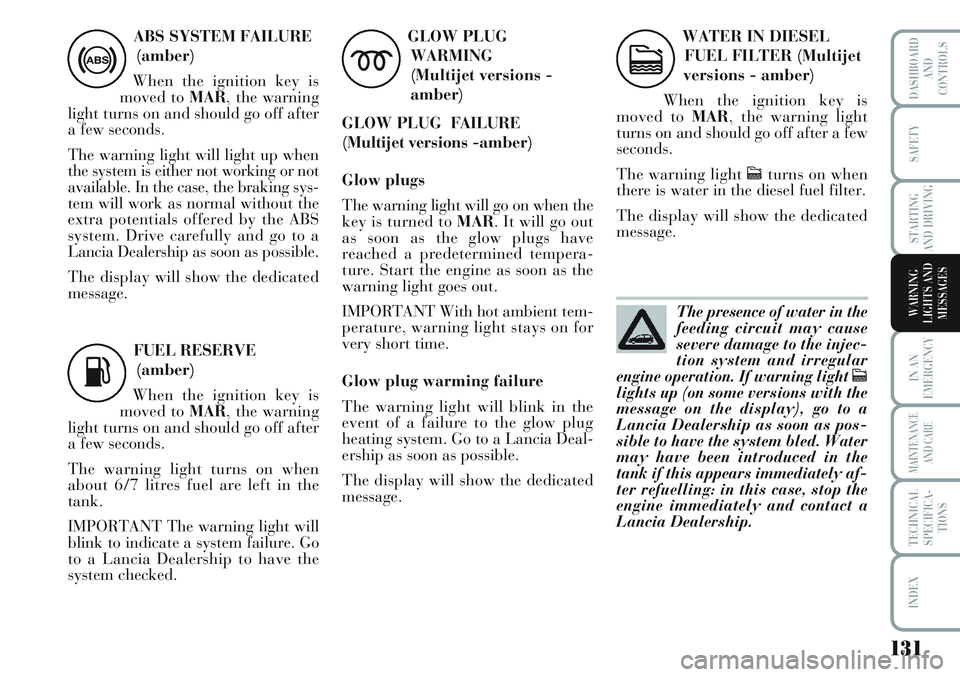
131
IN AN
EMERGENCY
MAINTENANCE
AND CARE
TECHNICAL
SPECIFICA-
TIONS
INDEX
DASHBOARD
AND
CONTROLS
SAFETY
STARTING
AND DRIVING
WARNING
LIGHTS AND
MESSAGES
ABS SYSTEM FAILURE
(amber)
When the ignition key is
moved to MAR, the warning
light turns on and should go off after
a few seconds.
The warning light will light up when
the system is either not working or not
available. In the case, the braking sys-
tem will work as normal without the
extra potentials offered by the ABS
system. Drive carefully and go to a
Lancia Dealership as soon as possible.
The display will show the dedicated
message.
>
FUEL RESERVE
(amber)
When the ignition key is
moved to MAR, the warning
light turns on and should go off after
a few seconds.
The warning light turns on when
about 6/7 litres fuel are left in the
tank.
IMPORTANT The warning light will
blink to indicate a system failure. Go
to a Lancia Dealership to have the
system checked.
K
GLOW PLUG
WARMING
(Multijet versions -
amber)
GLOW PLUG FAILURE
(Multijet versions -amber)
Glow plugs
The warning light will go on when the
key is turned to MAR. It will go out
as soon as the glow plugs have
reached a predetermined tempera-
ture. Start the engine as soon as the
warning light goes out.
IMPORTANT With hot ambient tem-
perature, warning light stays on for
very short time.
Glow plug warming failure
The warning light will blink in the
event of a failure to the glow plug
heating system. Go to a Lancia Deal-
ership as soon as possible.
The display will show the dedicated
message.
m
WATER IN DIESEL
FUEL FILTER (Multijet
versions - amber)
When the ignition key is
moved to MAR, the warning light
turns on and should go off after a few
seconds.
The warning light cturns on when
there is water in the diesel fuel filter.
The display will show the dedicated
message.
c
The presence of water in the
feeding circuit may cause
severe damage to the injec-
tion system and irregular
engine operation. If warning light c
lights up (on some versions with the
message on the display), go to a
Lancia Dealership as soon as pos-
sible to have the system bled. Water
may have been introduced in the
tank if this appears immediately af-
ter refuelling: in this case, stop the
engine immediately and contact a
Lancia Dealership.
Page 151 of 218
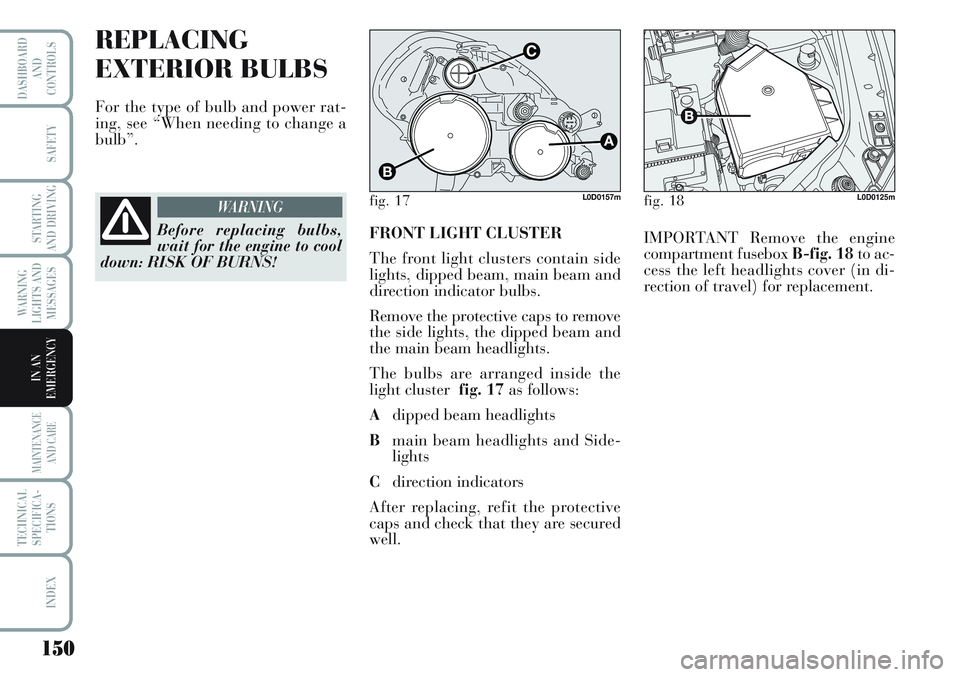
150
WARNING
LIGHTS AND
MESSAGES
MAINTENANCE
AND CARE
TECHNICAL
SPECIFICA-
TIONS
INDEX
DASHBOARD
AND
CONTROLS
SAFETY
STARTING
AND DRIVING
IN AN
EMERGENCY
REPLACING
EXTERIOR BULBS
For the type of bulb and power rat-
ing, see “When needing to change a
bulb”.
FRONT LIGHT CLUSTER
The front light clusters contain side
lights, dipped beam, main beam and
direction indicator bulbs.
Remove the protective caps to remove
the side lights, the dipped beam and
the main beam headlights.
The bulbs are arranged inside the
light cluster fig. 17as follows:
Adipped beam headlights
Bmain beam headlights and Side-
lights
Cdirection indicators
After replacing, refit the protective
caps and check that they are secured
well.IMPORTANT Remove the engine
compartment fusebox B-fig. 18to ac-
cess the left headlights cover (in di-
rection of travel) for replacement.
fig. 18L0D0125mfig. 17L0D0157m
Before replacing bulbs,
wait for the engine to cool
down: RISK OF BURNS!
WARNING
Page 157 of 218
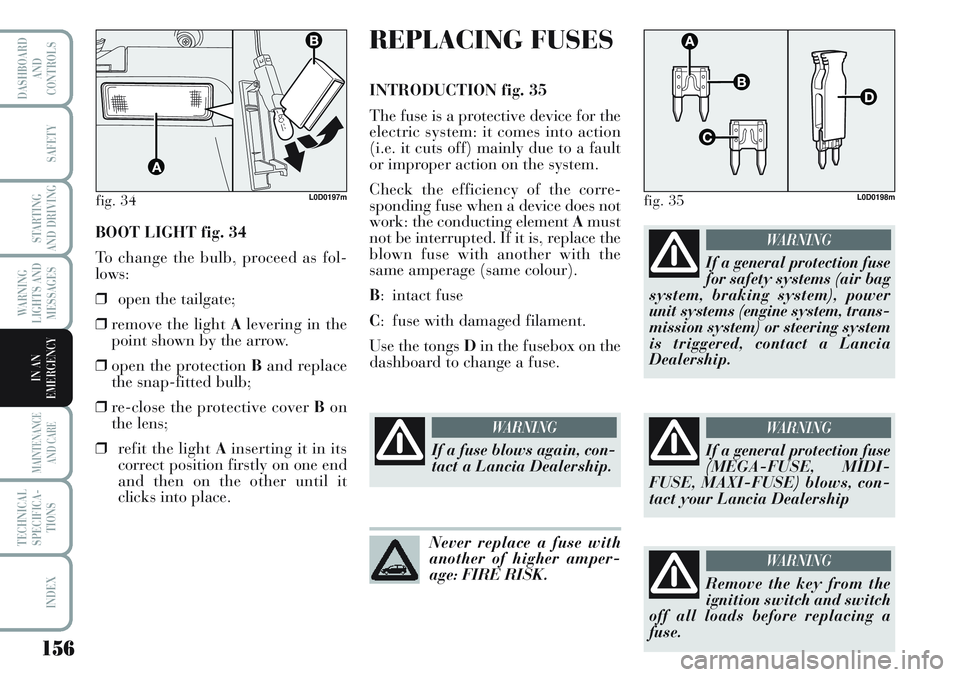
156
WARNING
LIGHTS AND
MESSAGES
MAINTENANCE
AND CARE
TECHNICAL
SPECIFICA-
TIONS
INDEX
DASHBOARD
AND
CONTROLS
SAFETY
STARTING
AND DRIVING
IN AN
EMERGENCY
BOOT LIGHT fig. 34
To change the bulb, proceed as fol-
lows:
❒open the tailgate;
❒remove the light Alevering in the
point shown by the arrow.
❒open the protection Band replace
the snap-fitted bulb;
❒re-close the protective cover Bon
the lens;
❒refit the light Ainserting it in its
correct position firstly on one end
and then on the other until it
clicks into place.
fig. 34L0D0197m
REPLACING FUSES
INTRODUCTION fig. 35
The fuse is a protective device for the
electric system: it comes into action
(i.e. it cuts off) mainly due to a fault
or improper action on the system.
Check the efficiency of the corre-
sponding fuse when a device does not
work: the conducting element Amust
not be interrupted. If it is, replace the
blown fuse with another with the
same amperage (same colour).
B: intact fuse
C: fuse with damaged filament.
Use the tongs Din the fusebox on the
dashboard to change a fuse.
fig. 35L0D0198m
If a fuse blows again, con-
tact a Lancia Dealership.
WARNING
Never replace a fuse with
another of higher amper-
age: FIRE RISK.
If a general protection fuse
(MEGA-FUSE, MIDI-
FUSE, MAXI-FUSE) blows, con-
tact your Lancia Dealership
WARNING
Remove the key from the
ignition switch and switch
off all loads before replacing a
fuse.
WARNING
If a general protection fuse
for safety systems (air bag
system, braking system), power
unit systems (engine system, trans-
mission system) or steering system
is triggered, contact a Lancia
Dealership.
WARNING
Page 168 of 218
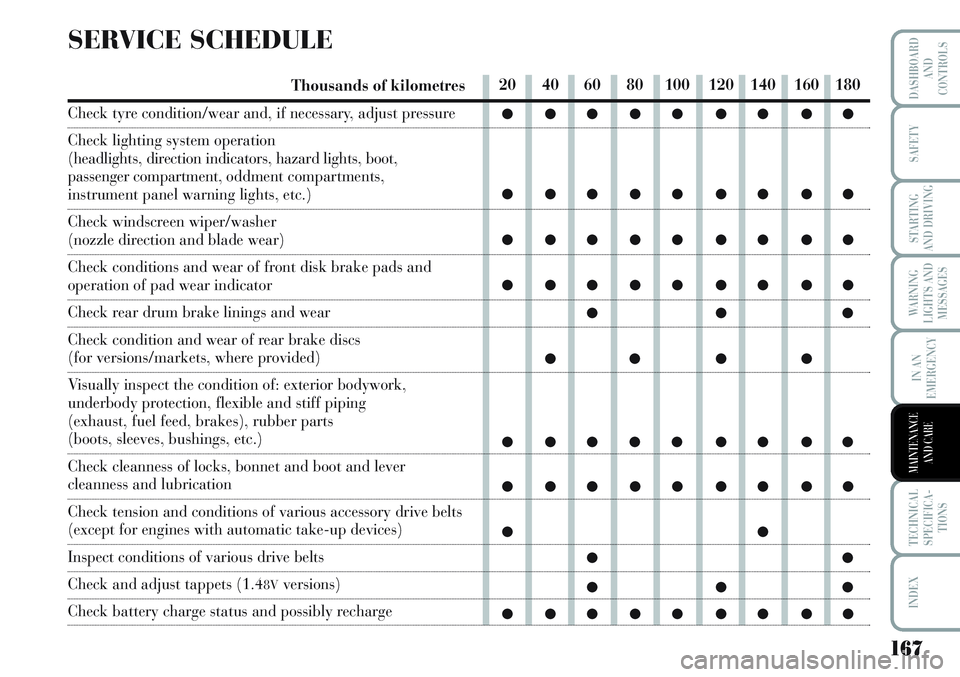
167
WARNING
LIGHTS AND
MESSAGES
TECHNICAL
SPECIFICA-
TIONS
INDEX
DASHBOARD
AND
CONTROLS
SAFETY
STARTING
AND DRIVING
IN AN
EMERGENCY
MAINTENANCE
AND CARE
SERVICE SCHEDULE
Thousands of kilometres
Check tyre condition/wear and, if necessary, adjust pressure
Check lighting system operation
(headlights, direction indicators, hazard lights, boot,
passenger compartment, oddment compartments,
instrument panel warning lights, etc.)
Check windscreen wiper/washer
(nozzle direction and blade wear)
Check conditions and wear of front disk brake pads and
operation of pad wear indicator
Check rear drum brake linings and wear
Check condition and wear of rear brake discs
(for versions/markets, where provided)
Visually inspect the condition of: exterior bodywork,
underbody protection, flexible and stiff piping
(exhaust, fuel feed, brakes), rubber parts
(boots, sleeves, bushings, etc.)
Check cleanness of locks, bonnet and boot and lever
cleanness and lubrication
Check tension and conditions of various accessory drive belts
(except for engines with automatic take-up devices)
Inspect conditions of various drive belts
Check and adjust tappets (1.48Vversions)
Check battery charge status and possibly recharge
20 40 60 80 100 120 140 160 180
●●●●● ●●●●
●●●●● ●●●●
●●●●● ●●●●
●●●●● ●●●●
●●●
●● ● ●
●●●●● ●●●●
●●●●● ●●●●
●●
●●
●●●
●●●●● ●●●●
Page 169 of 218
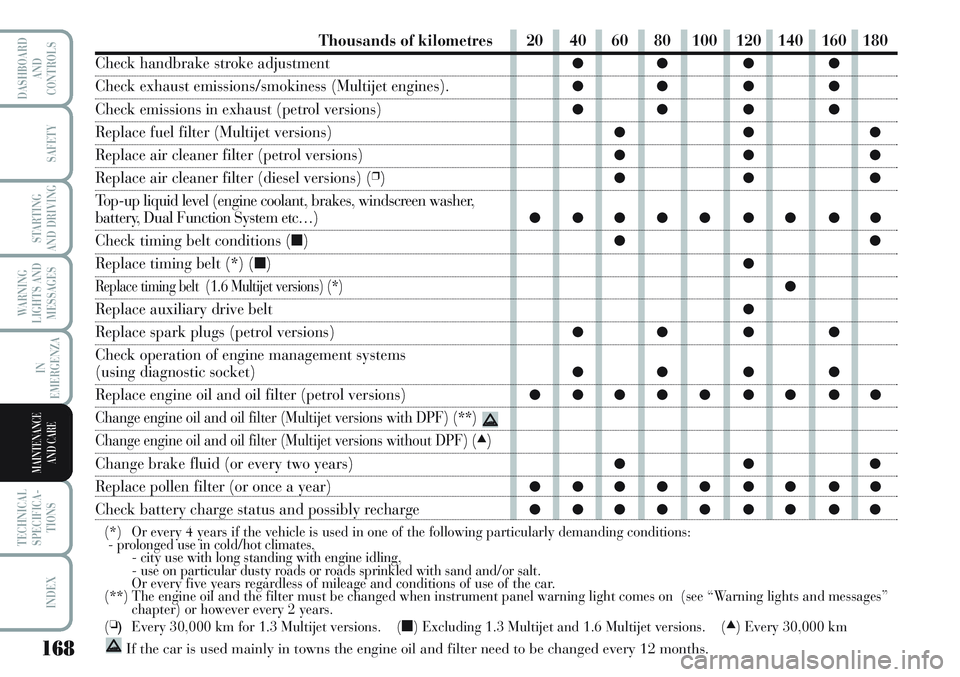
168
WARNING
LIGHTS AND
MESSAGES
TECHNICAL
SPECIFICA-
TIONS
INDEX
DASHBOARD
AND
CONTROLS
SAFETY
STARTING
AND DRIVING
IN
EMERGENZA
MAINTENANCE
AND CARE
Thousands of kilometres
Check handbrake stroke adjustment
Check exhaust emissions/smokiness (Multijet engines).
Check emissions in exhaust (petrol versions)
Replace fuel filter (Multijet versions)
Replace air cleaner filter (petrol versions)
Replace air cleaner filter (diesel versions) (❒)
Top-up liquid level (engine coolant, brakes, windscreen washer,
battery, Dual Function System etc…)
Check timing belt conditions (■)
Replace timing belt (*) (■)
Replace timing belt (1.6 Multijet versions) (*)
Replace auxiliary drive belt
Replace spark plugs (petrol versions)
Check operation of engine management systems
(using diagnostic socket)
Replace engine oil and oil filter (petrol versions)
Change engine oil and oil filter (Multijet versions with DPF) (**)
Change engine oil and oil filter (Multijet versions without DPF) (▲)
Change brake fluid (or every two years)
Replace pollen filter (or once a year)
Check battery charge status and possibly recharge
(*) Or every 4 years if the vehicle is used in one of the following particularly demanding conditions:
- prolonged use in cold/hot climates,
- city use with long standing with engine idling,
- use on particular dusty roads or roads sprinkled with sand and/or salt.
Or every five years regardless of mileage and conditions of use of the car.
(**) The engine oil and the filter must be changed when instrument panel warning light comes on (see “Warning lights and messages”
chapter) or however every 2 years.
(
❏)Every 30,000 km for 1.3 Multijet versions. (■) Excluding 1.3 Multijet and 1.6 Multijet versions. (▲) Every 30,000 km
If the car is used mainly in towns the engine oil and filter need to be changed every 12 months.
20 40 60 80 100 120 140 160 180
●● ● ●
●● ● ●
●● ● ●
●●●
●●●
●●●
●●●●● ●●●●
●●
●
●
●
●● ● ●
●● ● ●
●●●●● ●●●●
●●●
●●●●● ●●●●
●●●●● ●●●●
Page 170 of 218
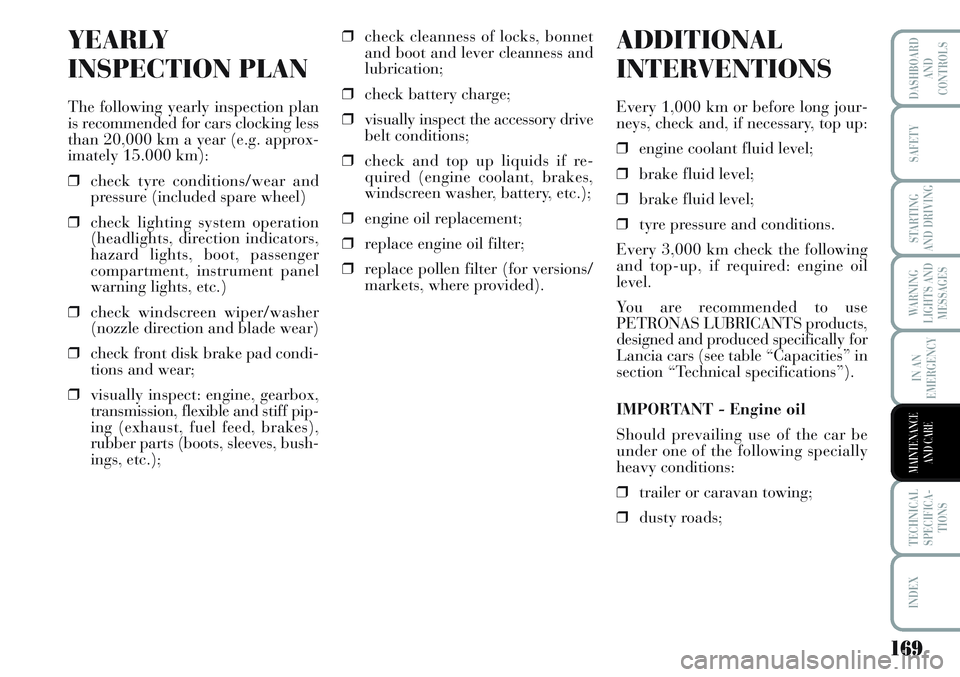
169
WARNING
LIGHTS AND
MESSAGES
TECHNICAL
SPECIFICA-
TIONS
INDEX
DASHBOARD
AND
CONTROLS
SAFETY
STARTING
AND DRIVING
IN AN
EMERGENCY
MAINTENANCE
AND CARE
YEARLY
INSPECTION PLAN
The following yearly inspection plan
is recommended for cars clocking less
than 20,000 km a year (e.g. approx-
imately 15.000 km):
❒check tyre conditions/wear and
pressure (included spare wheel)
❒check lighting system operation
(headlights, direction indicators,
hazard lights, boot, passenger
compartment, instrument panel
warning lights, etc.)
❒check windscreen wiper/washer
(nozzle direction and blade wear)
❒check front disk brake pad condi-
tions and wear;
❒visually inspect: engine, gearbox,
transmission, flexible and stiff pip-
ing (exhaust, fuel feed, brakes),
rubber parts (boots, sleeves, bush-
ings, etc.);❒check cleanness of locks, bonnet
and boot and lever cleanness and
lubrication;
❒check battery charge;
❒visually inspect the accessory drive
belt conditions;
❒check and top up liquids if re-
quired (engine coolant, brakes,
windscreen washer, battery, etc.);
❒engine oil replacement;
❒replace engine oil filter;
❒replace pollen filter (for versions/
markets, where provided).
ADDITIONAL
INTERVENTIONS
Every 1,000 km or before long jour-
neys, check and, if necessary, top up:
❒engine coolant fluid level;
❒brake fluid level;
❒brake fluid level;
❒tyre pressure and conditions.
Every 3,000 km check the following
and top-up, if required: engine oil
level.
You are recommended to use
PETRONAS LUBRICANTS products,
designed and produced specifically for
Lancia cars (see table “Capacities” in
section “Technical specifications”).
IMPORTANT - Engine oil
Should prevailing use of the car be
under one of the following specially
heavy conditions:
❒trailer or caravan towing;
❒dusty roads;
Page 171 of 218
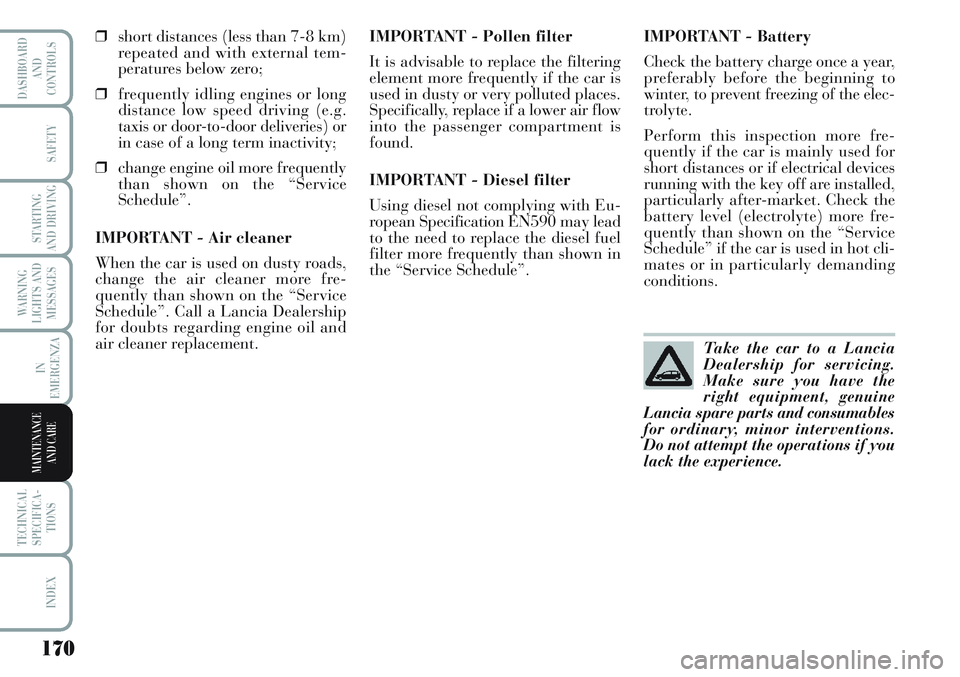
170
WARNING
LIGHTS AND
MESSAGES
TECHNICAL
SPECIFICA-
TIONS
INDEX
DASHBOARD
AND
CONTROLS
SAFETY
STARTING
AND DRIVING
IN
EMERGENZA
MAINTENANCE
AND CARE
❒short distances (less than 7-8 km)
repeated and with external tem-
peratures below zero;
❒frequently idling engines or long
distance low speed driving (e.g.
taxis or door-to-door deliveries) or
in case of a long term inactivity;
❒change engine oil more frequently
than shown on the “Service
Schedule”.
IMPORTANT - Air cleaner
When the car is used on dusty roads,
change the air cleaner more fre-
quently than shown on the “Service
Schedule”. Call a Lancia Dealership
for doubts regarding engine oil and
air cleaner replacement. IMPORTANT - Pollen filter
It is advisable to replace the filtering
element more frequently if the car is
used in dusty or very polluted places.
Specifically, replace if a lower air flow
into the passenger compartment is
found.
IMPORTANT - Diesel filter
Using diesel not complying with Eu-
ropean Specification EN590 may lead
to the need to replace the diesel fuel
filter more frequently than shown in
the “Service Schedule”.IMPORTANT - Battery
Check the battery charge once a year,
preferably before the beginning to
winter, to prevent freezing of the elec-
trolyte.
Perform this inspection more fre-
quently if the car is mainly used for
short distances or if electrical devices
running with the key off are installed,
particularly after-market. Check the
battery level (electrolyte) more fre-
quently than shown on the “Service
Schedule” if the car is used in hot cli-
mates or in particularly demanding
conditions.
Take the car to a Lancia
Dealership for servicing.
Make sure you have the
right equipment, genuine
Lancia spare parts and consumables
for ordinary, minor interventions.
Do not attempt the operations if you
lack the experience.
Page 172 of 218
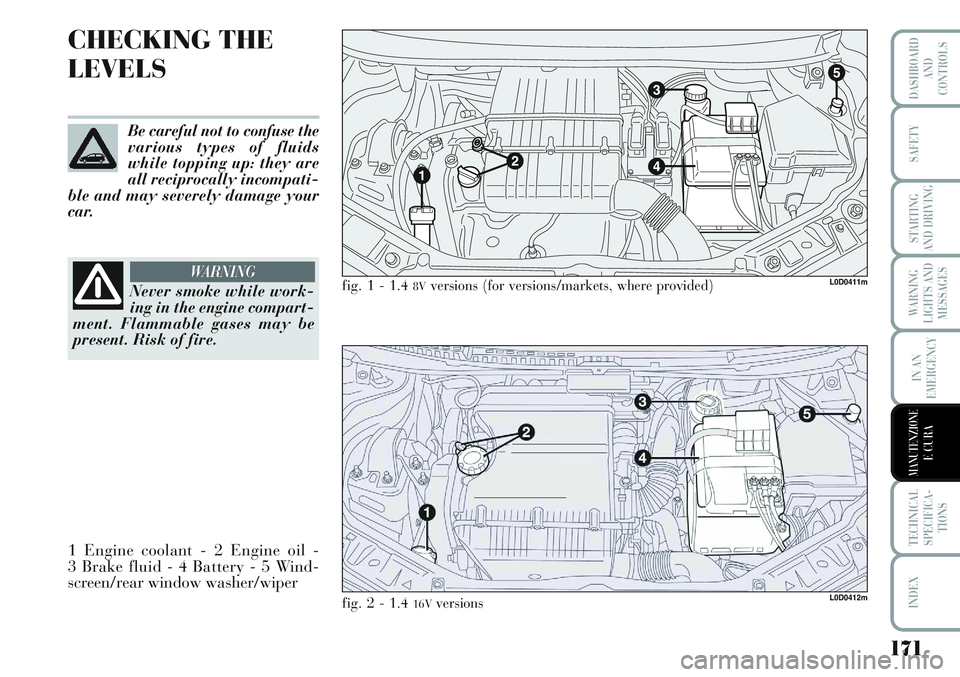
171
WARNING
LIGHTS AND
MESSAGES
TECHNICAL
SPECIFICA-
TIONS
INDEX
DASHBOARD
AND
CONTROLS
SAFETY
STARTING
AND DRIVING
IN AN
EMERGENCY
MANUTENZIONEE CURA
CHECKING THE
LEVELS
L0D0411m
L0D0412m
fig. 1 - 1.48Vversions (for versions/markets, where provided)
fig. 2 - 1.416Vversions
Never smoke while work-
ing in the engine compart-
ment. Flammable gases may be
present. Risk of fire.
WARNING
1 Engine coolant - 2 Engine oil -
3 Brake fluid - 4 Battery - 5 Wind-
screen/rear window washer/wiperBe careful not to confuse the
various types of fluids
while topping up: they are
all reciprocally incompati-
ble and may severely damage your
car.